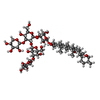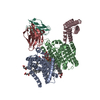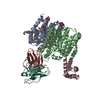+Search query
-Structure paper
| Title | Regulated degradation of HMG CoA reductase requires conformational changes in sterol-sensing domain. |
|---|---|
| Journal, issue, pages | Nat Commun, Vol. 13, Issue 1, Page 4273, Year 2022 |
| Publish date | Jul 25, 2022 |
 Authors Authors | Hongwen Chen / Xiaofeng Qi / Rebecca A Faulkner / Marc M Schumacher / Linda M Donnelly / Russell A DeBose-Boyd / Xiaochun Li /  |
| PubMed Abstract | 3-Hydroxy-3-methylglutaryl coenzyme A reductase (HMGCR) is the rate-limiting enzyme in cholesterol synthesis and target of cholesterol-lowering statin drugs. Accumulation of sterols in endoplasmic ...3-Hydroxy-3-methylglutaryl coenzyme A reductase (HMGCR) is the rate-limiting enzyme in cholesterol synthesis and target of cholesterol-lowering statin drugs. Accumulation of sterols in endoplasmic reticulum (ER) membranes accelerates degradation of HMGCR, slowing the synthesis of cholesterol. Degradation of HMGCR is inhibited by its binding to UBIAD1 (UbiA prenyltransferase domain-containing protein-1). This inhibition contributes to statin-induced accumulation of HMGCR, which limits their cholesterol-lowering effects. Here, we report cryo-electron microscopy structures of the HMGCR-UBIAD1 complex, which is maintained by interactions between transmembrane helix (TM) 7 of HMGCR and TMs 2-4 of UBIAD1. Disrupting this interface by mutagenesis prevents complex formation, enhancing HMGCR degradation. TMs 2-6 of HMGCR contain a 170-amino acid sterol sensing domain (SSD), which exists in two conformations-one of which is essential for degradation. Thus, our data supports a model that rearrangement of the TMs in the SSD permits recruitment of proteins that initate HMGCR degradation, a key reaction in the regulatory system that governs cholesterol synthesis. |
 External links External links |  Nat Commun / Nat Commun /  PubMed:35879350 / PubMed:35879350 /  PubMed Central PubMed Central |
| Methods | EM (single particle) |
| Resolution | 3.23 - 3.6 Å |
| Structure data | EMDB-27460: HMGCR-UBIAD1 Complex Dimer EMDB-27461: HMGCR-UBIAD1 Complex Monomer  EMDB-27475: HMGCR-UBIAD1-BRIL-Fab-Nb Complex  EMDB-27477: HMGCR(40-55 deletion)-UBIAD1 Complex Dimer  EMDB-27478: HMGCR(40-55 deletion)-UBIAD1 Complex Monomer |
| Chemicals |  ChemComp-Y01:  ChemComp-AJP: |
| Source |
|
 Keywords Keywords | Oxidoreductase/Immune System / Cholesterol / MEMBRANE PROTEIN / Oxidoreductase-Immune System complex |
 Movie
Movie Controller
Controller Structure viewers
Structure viewers About Yorodumi Papers
About Yorodumi Papers









